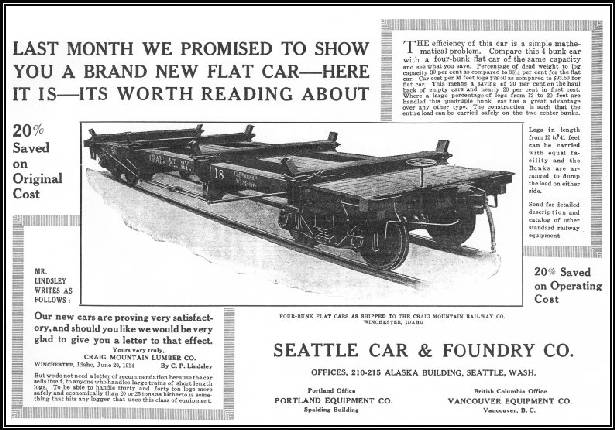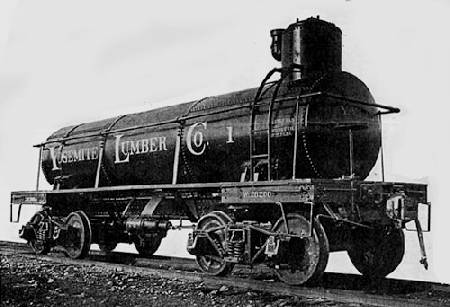Pacific Car & Foundry
Railway Steel & Supply Company
|
 |
| Photo courtesy of Loggers, Railroads and Pine website, “Ancient Ads.” Used with permission. Click pic for enlargement. |
“In the eight years from 1910 through 1917, the company built an average of 656 railway and 107 industrial cars per year, mostly to handle logs. Of the 840 cars manufactured in 1910, for example, 300 were boxcars for the Northern Pacific, but most of the remainder were cars and trucks designed to transport logs.” Among the products manufactured were box, flat and gondola cars, logging cars, trucks, bunks and chocks, caboose cars, camp cars, contractors dump cars, push cars, quarry cars, track construction cars and tram cars. {73}
In August of 1917, the company merged with its biggest west coast competitor, the contracting firm of Twohy Brothers Company of Portland, and emerged as the Pacific Car & Foundry Company. The merger was an uneasy one, for the Twohy brothers and William Pigott did not see eye-to-eye on company finances. Nevertheless, it now gave Pacific Car & Foundry plants in both Renton and Portland.
In 1918, the company received an order for 2,000 steel boxcars from the United States Railway Administration, which had taken over the railroads 26 December 1917 shortly after the United States entered what would become the 1st World War. The tension between William Pigott and the Twohy brothers dictated that the order be split between the plants, so both plants had to be upgraded to handle the volume.
But by 1920, with the war over and the railroads returned to their owners, general car building orders shrank, largely due to the railroads deciding to build their own cars. The shipbuilding business, into which the Twohy brothers had ventured, floundered. And the lumber camps and sawmills laid off workers as the price of lumber dropped.
The one bright spot on the horizon was the company’s line of logging trucks (and here we do mean the kind you drive). In 1915 the company had designed and developed a motor truck with a two-wheeled trailer for hauling logs. The truck-trailer—known as the “Universal Trailer”—had became widely used during the ensuing years, and now became the primary product of the Renton plant.
Meanwhile, the Portland plant was successful in obtaining orders for building and repair of refrigerated cars, and this eventually became its specialty.
 |
| One of the more interesting—and unique—cars built by Seattle Car & Foundry was this tank car built for the Yosemite Lumber Company for use on a 7,800' incline with grades up to 78%. The expansion dome had to be placed at the uphill end of the car to avoid spillage, and special flanges between the tank and the frame kept the tank from slipping out of the hold-down bands. Drawings and photos of this car may be found in the May/June 2004 issue of Narrow Gauge & Short Line Gazette. |
By the time William Pigott retired in January 1921, the company had built more than 7,000 logging cars and countless refrigerated box cars. It had pioneered in safety features such as air brakes and an open-framed design that reduced injuries to loggers. And it had developed the two-wheeled trailer pulled by a motor truck that quickly became an industry standard. The Portland plant was producing refrigerated box cars and repairing train cars under contract, while the Renton plant built a variety of train cars and motor trucks. Pigott predicted the demand for railroad rolling stock would decline (after being over-built, perhaps, by the USRA, which had relinquished control of the railroads just six months earlier).
The company was acquired 31 March 1924 by the American Car & Foundry Company as part of its national expansion. William Pigott approved the deal, which was done at least partly to solve financial problems of the Twohy brothers. Pacific Car & Foundry would be a wholly-owned subsidiary of AC&F, but continue to do business under its own name. While continuing rail car production, it expanded its product line to include steel bridges and buses. But its profits steadily delined.
The Renton plant suffered hard times during the early depression years as demand for rail cars dropped. On 31 March 1934, William J. and Paul Pigott—sons of the founder—organized a consortium and were able to buy the company back from American Car & Foundry for $50,000. AC&F was happy to be rid of the money-losing operation, and the Pigott family—which had been unhappy with the sale almost from the day it happened—were thrilled to have their company back.
By this time, only the Renton and Portland plants were open, with a combined capacity of 750 cars a month. {245}
By the late 1930s, Pacific Car was doing steel fabrication for many major bridges and dams, for Boeing aircraft and other Seattle firms, while its Motor Coach Division built buses and trackless trolleys for the City of Seattle.
During the 2nd World War, Pacific Car had a number of defense contracts, and cast huge panels of steel and armor for more than 900 Sherman tanks. In 1945, the company moved into the truck business when it acquired the Kenworth Motor Truck Corporation.
By the 1950s, Pacific Car was in almost too many different businesses to count, but it was still considered the leading builder of refrigerated and insulated railway cars. In 1958 it acquired the Dart Truck Company of Kansas City and the Peterbilt Motors Company of Oakland, California.
Paul Pigott ran the company as chairman and CEO until his death in 1961, when he was succeeded by his son Charles Pigott.
In 1972, the company’s name was changed to PACCAR. The Renton plant, which still made rail cars, became a division and was known as Pacific Car & Foundry, specializing in refrigerator cars. But in the 1970s the rail car business slowed as the trailer-truck business made up most of PACCAR’s business, and by 1984 the company was out of the rail car business.
You can read more about PACCAR’s businesses at the Seattle/King County History Link.
Cast of Characters —
William Pigott (1860-1929) was born in New York City to Irish immigrant parents. The family moved to Hubbard, Ohio, where he grew up. He was employed by a local steel mill as a salesman, and was successful in that field. He became a partner in a blast furnace at Syracuse, New York, but it failed. He subsequently became a partner in a steel mill in Colorado, and that business was eminently successful.
Pigott came to Seattle in 1895, where he joined a former partner in selling steel rails and railway supplies to loggers. But demand was slack in the wake of the financial panic of 1893, and the partners barely hung on. Business picked up again slowly, until hyper-stimulated by the discovery of gold in the Yukon Territory in mid-1897.
Pigott separated from his partner in 1901 to start the Railway & Steel Supply Company, dealing in rails, railway supplies, steel, pig iron and coke. But he dreamed of making Seattle a real steel town, and 23 January 1903 incorporated the Seattle Steel Company to smelt the local ores into pig iron, which in turn could be rolled into steel. A new works was built at Humphrey, and began operating 4 May 1905. In 1913, it would become Pacific Coast Steel Company.
Pigott saw another opportunity in the lumber industry, and in 1904 he incorporated the North Coast Dry Kiln & Truck Company to build drying kilns for lumber and shingles.
Pigott served on the Seattle School Board, beginning in 1908, and was elected its president in 1914. He supported numerous charities, both with money and with service. He fostered corporate responsibility long before it was considered fashionable. He was asked to run for public office, but declined for various reasons.
Pigott retired as president of Pacific Car January 1921. He died in 1929.
The original Twohy brothers were John W. (1854-1927), James C. (1856-1908) and Dennis D. (1859-1909 ), sons of John and Lucy Tuohy who had emigrated from Ireland in 1845. After various jobs and enterprises, in the early 1890s, James and Dennis successfully established themselves as Twohy Brothers Railroad Contractors at Helena, Montana. About 1898, their brother John, after a 15-year career as attorney and judge decided to join them, now at Spokane, Washington.
During the next 10 years, the company was quite successful at building railroads in the Pacific Northwest, and several other family members became a part of it. But in 1908 James—and in 1909 Dennis—died, leaving “Judge”John to carry on. On 25 January 1910 he reorganized the business as Twohy Brothers Company, Inc., an Oregon corporation, with himself as President and his sons John D. (1885-1930) and James F. (1889-1976) as Vice-President/General Manager and Secretary/Treasurer respectively.
They were soon engaged in a variety of projects, including car repair and maintenance. When they found themselves with more shop capacity than they needed to fill their own requirements, they began building cars for others, and thus became competitors to Seattle Car & Foundry.
In 1916 the Union Pacific split an order for 400 steel underframe box cars between the two firms, and shortly thereafter the Southern Pacific did likewise with an order for 300 wooden box cars. The owners of the two firms knew each other, and decided their best future was as one company.
The exact nature of the combination is not clear. Twohy-84 says they “merged ... pooled their real estate, machinery, tools and raw materials, as well as their work forces of skilled mechanics, to form Pacific car and Foundry.” But he then goes on to describe continuing activities of the company, and the fact that by 1931 the depression had reduced it to “a corporation in name only.” {123}
For More Information —
Groner, Alex. PACCAR: The Pursuit of Quality. Bellevue, WA: Documentary Book Publishing Co., 1981.
A corporate history of Pacific Car & Foundry, which became PACCAR in 1971.
Marschutz & Cantrell Disconnected Log Truck built by Seattle Car & Foundry (plan). Narrow Gauge and Short Line Gazette, Jul/Aug 1995, p. 60.
Paul Pigott and Seattle investors buy back Pacific Car and Foundry Co. on February 27, 1934. Seattle/King County HistoryLink.org. The online encyclopedia of Seattle / King County History.
Twohy, John Roger.
Ten Spikes to the Rail; Twohy Brothers - Early Day Northwestern Railroad Builders. Jenner, CA: Goat Rock Publications, 1983.A fascinating little book that records in detail the lives and works of an immigrant family that founded and built a powerful contracting business specializing in railroad construction in the Pacific Northwest. Besides business and family lore, it contains excellent discussion of national political and economic conditions of the U.S. from about 1850 to 1950.
1913 Seattle Car & Foundry Company Catalog. Reprint 2003 by Northwest Short Line, Seattle, Washington.
76 page catalog with numerous photos and drawings of logging railroad cars and associated equipment.